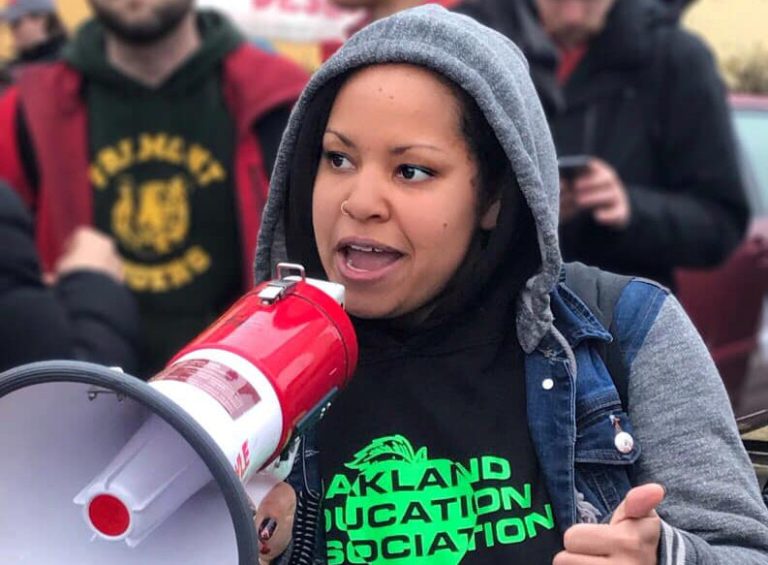School District Prepares for Second Round of School Closures
Jun 28, 2019
The district also is beginning the process of selling or leasing school properties.

By Ken Epstein
The Board of Education is moving ahead with a second set of school closures, mergers and consolidations, called “Cohort 2,”which is scheduled to be approved in August.
The plan, called the “Blueprint for Quality Schools Update,” was presented to the community at the June 19 school board meeting by Supt. Kyla Johnson Trammell and Yvette Renteria, Deputy Chief of Innovation, who promoted the district’s decision to reduce the number of Oakland schools as a way to save money and improve the quality of the remaining schools.
Opposing the administrators’ approach were Oakland Education Association (OEA) members who participated in the district’s Ad Hoc Committee on school closure, which was established to provide community involvement in the process.
OEA members on the committee criticized the district for lack of transparency and engagement with the community, saying that except for the teacher union representatives on the committee, all of the 15-20 participants in the closed-door meetings were selected by the district.
The OEA teachers’ counter report, presented at the board meeting by OEA member and Reach Academy teacher Megan Bumpus, said there is no evidence or research from the wave of school closures across the country that indicates that shutting down public schools saves money or improves the remaining schools and particularly harms Black and Brown students, who overwhelmingly are those who are most impacted.
Asked by the Oakland Post for a list of school closings for next year that are scheduled to be approved in a little over a month, the district produced a PowerPoint slide called “Cohort 2 Scenarios,” which indicated it was “applying recommendations from the Ad Hoc Committee” but was more murky than transparent about what the district is planning to do.
Listed on the PowerPoint slide were possible mergers of Kaiser Elementary School with Sankofa on the Sankofa campus, which might also include Peralta and the “soon-to-be-vacant” Santa Fe Elementary. Also mentioned were a merger of Manzanita SEED, Manzanita Community School, Oakland SOL and Fruitvale Elementary, which might be redesigned. A proposed expansion of Melrose Leadership Academy and a new location for Oakland SOL “may impact nearby schools,” the slide said.
The goal of these changes, according to the administrators’ presentation, is to “concentrate resources in fewer schools,” based on the idea that “with fewer schools, central office supports and services will be more efficient and leaner.”
According to the plan, the campuses of schools that will be closed can be leased or sold to generate income. With more money and fewer schools, the plan says optimistically, the district will recruit and retain better school leaders. In addition, “larger schools provide opportunities for teachers to collaborate and support one another.”
The OEA teachers’ rebuttal was blunt. “If the goal is saving money, closing schools won’t do that. If the goal is expanding access to quality schools, closing school won’t do it,” the report said.
“As the district has been unable to provide any research-based rational for closing, consolidating or merging schools…OEA members of the Ad Hoc Committee could not participate in the misleading survey the district staff used to develop the committee’s recommendations or sign onto (those) recommendations,” said Bumpus, speaking at the board meeting.
When OEA members pressed administrator Renteria about how much money the district saved when it closed five schools in 2011-2012, she replied “We don’t have information on what money was saved,” the report said.
“Fourteen of the 18 OUSD schools closed since 2002 now house charter schools, which we know are leeching $57 million annually from students in Oakland,” Bumpus said, citing the OEA report.
“Given the realities of the OUSD’s highly class- and race-segregated schools and an enrollment process that disproportionately concentrates need, it is no mistake that schools targeted for closure and consolidation have student populations in which African American, Latinx, special education students and students with trauma are highly represented,” she said, adding that 17 of the 18 schools closed since 2001 were majority African American.
Looking at the closure of Cohort 1 school Roots International Academy, a neighborhood middle school in East Oakland, Bumpus said teachers “rebuke the district for the irreparable harm done to the Roots community in this past school year” and called on the district to “take the path of improvement,” rather than the path of closures.
The district’s 7-11 Committee, charged with approving “surplus properties for sale or lease, was scheduled Wednesday evening to be approved by the school board to begin considering the sale or lease of “First Phase Properties.”
The four vacant properties are: Edward Shands Adult School, Tilden CDC, Piedmont CDC, Webster CDC and Sankofa CDC.
The district currently has 86 schools. The Fiscal Crisis Management and Assistance Team (FCMAT), a state-funded nonprofit that has been driving school closures in Oakland since 2003, has said publicly that the district should not have more than about 50 schools.
The full report on school closings by OEA members is available at http://bit.ly/OEAAdHocReport